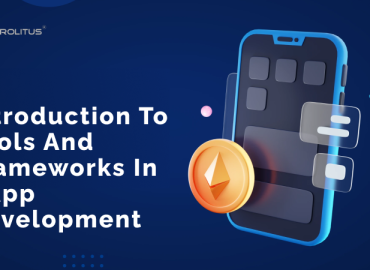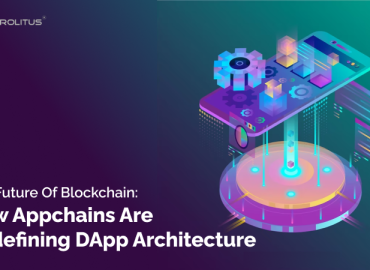The 21st century saw the rise of the Internet at a relatively faster pace. Now that the Internet is accessible to billions of people, crypto is taking over the world. One can easily find a person discussing crypto, blockchain, and DApp. But, not everyone knows the meaning of DeFi and the process of building a DeFi App.
Although DeFi is one of the popular aspects that provides freedom from traditional finance, it is still a mystery to many individuals. Not everyone seeks the investment side; some want to learn the phenomenon behind it and how they can start building a DeFi app of their own.
Are you one of those who thinks DeFi is complex and intricate? Here is a beginner-friendly guide to learning about DeFi and the process of building your first DeFi app. Let’s get started!
What is DeFi?
DeFi is short for Decentralized Finance. It is an umbrella term that defines the whole financial infrastructure and emphasizes decentralization. DeFi is closely related to cryptocurrencies or the blockchain technology behind crypto.
Decentralized finance (DeFi) is a financial technology based on distributed ledgers that share similarities with cryptocurrencies. It gives freedom to users from banks and institutions as they no longer control money, financial products, and financial services.
We can understand DeFi protocols best by understanding decentralized finance. DeFi refers to the transition from centralized financial systems to peer-to-peer funding. Also, DeFi has created a range of financial products such as tokenized digital currency, stablecoins, and a lending and borrowing platform.
What are the main elements of DeFi?
As we already read above, we will cover the three major elements of DeFi: lending and borrowing, stablecoins, and decentralized exchanges. Let’s discuss them in brief.
Lending and borrowing
Decentralized finance provides an option of lending to people where investors deposit fiat money through a decentralized application (DApp) and earn interest. An individual can borrow the funds which need to be paid back along with interest before a predetermined date.
The best part is the use of smart contracts to execute the transactions. Hence, no middlemen are involved in the entire process. Smart contracts also save time by removing the need for paperwork. A user can take out a loan through DeFi. Examples of DeFi projects are Compound, MakerDAO, and AAVE.
Stable Coins
Stablecoin is a form of cryptocurrency with its value pegged 1:1 to another asset like fiat money or exchange-traded commodity. They provide a stable option for investors. Users use stablecoins to trade goods and services, offering quicker and cheaper international transactions.
Stablecoins can also help users when a country’s economy is failing. The users can exchange their money for coins to preserve their wealth and security. Examples of stablecoins are USDT, USDC, and DAI.
Decentralized Exchanges (DEX)
Decentralized Exchanges allow people to trade digital assets by connecting buyers and sellers to make transactions via a peer-to-peer network. They are built on a blockchain, providing a secure and transparent platform without intermediates. Decentralized exchanges possess all the major features of a CEX and an option to trade numerous coins virtually.
A user can easily exchange cryptocurrencies virtually by connecting their wallets. Anonymity, lack of intermediaries, faster and cheaper transactions, and the prevention of market manipulation are some of the benefits of DEXs.
How does DeFi work?
Many people in their everyday life use decentralized finance. The classic example is peer-to-peer lending, where people can take loans without involving a bank. The loan amount is the accumulation of money people have deposited to earn interest.
DeFi is safe and transparent. Its working is similar to the current banking system, where the borrower chooses the amount of money to borrow and the repayment period on the platform. A user first stakes the money on a DeFi protocol and interacts with smart contracts. The platform deposits them in a liquidity pool that loans out to people via crypto-backed loans.
In return, users earn interest, and the funds help the network run. An individual can easily borrow and pay the amount within a stipulated period along with interest. Generally, all the DeFi platforms have the same set of rules, procedures, and protocols. The difference lies in the fees collected for every loan issued on the protocol.
How to build and deploy a DeFi App?
Before building our DeFi app, let’s have a glance to understand a DeFi app. It is a program on the Ethereum network that enables people to interact with financial products without needing an intermediary. A DeFi app uses three significant tools: Ethereum blockchain, smart contracts, and cryptography.
Generally, these apps aim for easy accessibility of financial services through open-source, trustless networks. DeFi apps harness the power of smart contracts and allow developers to build applications that offer lending and borrowing services without third-party involvement.
The tutorial below will provide an overview of how we can build a DeFi Application where users can deposit an ERC20 token to the smart contract. Let’s learn more about each step to create a Defi app effortlessly.
Install Truffle and Ganache
Since this is the first time you will interact with a smart contract, it is essential to set up your environment. We will use Truffle and Ganache tools to create a smart contract. While truffle is a development environment and testing framework for smart contracts, ganache helps to create a local Ethereum blockchain to test smart contracts.
ERC20 token creation
Now that you have set up the environment let’s move ahead to create our ERC20 token. It is a pre-configured smart contract to issue tokens to investors in exchange for ETH. Hence, it is necessary to install the OpenZeppelin library as it contains the implementations of Ethereum standards.
Deployment of ERC20 token
Before deploying the ERC20 token, ensure you have compiled your smart contract with the correct solidity compiler version. It is time to deploy your ERC20 token to the Ethereum network. Once you undergo this process, you will be able to receive ETH, BTC, and other cryptocurrencies for your tokens.
Test the newly created DeFi App
A crucial step is running all your smart contract methods like total supply, transfer, and balance to check for any errors. One can easily find these methods on the right-hand side of the remix window. As a good practice, you should try to transfer some tokens to an Ethereum wallet address. Ensure to call the balance method to check the Ethereum address’s balance.
Decentralized finance is revolutionizing the entire financial market by providing a method to perform transactions that suits the needs of the 21st century. DeFi is here to stay and will adapt to challenging market conditions. The best part is the realization of transfer from computer to computer without centralized exchange points.
Final Thoughts
Decentralized finance is making the entire process of doing transactions effortless and efficient. After involving trade with the DeFi app, you can save time, money, and resources spent on plenty of methods. For example, buying a car or home would be easy since you do not have to go through a lengthy process. The application will process all the stages quickly and easily.
Soon, decentralized finance can even bring in applications that no one has imagined. But, it shall be difficult for someone just starting in the space to build a DeFi app from scratch. Hence, it will be wise to consult a DeFi app development company that can solve all your blockchain needs.
Why should you choose Prolitus for developing your DeFi app?
Prolitus has an expert and professional team of blockchain developers with years of experience developing decentralized finance applications. The platform caters to all application needs to help you focus on the business while we take care of the platform development.
The team at prolitus is keen on details as it deals exclusively in the blockchain space. The expert team creates the best blend of your ideas based on your target audience. Get in touch with our team for all your blockchain needs!
Frequently Asked Questions (FAQs)
Q1. How can security holes occur in your DeFi app?
Ans. A security hole can occur when the code has any errors or vulnerabilities. Depending on the bug, it can drain the funds and cause damage to the platform. Hence, it is essential to have a foolproof DApp that can gain the people’s trust.
Q2. Is there an option to build a DeFi Wallet in your DeFi app?
Ans. Yes, you can create a wallet in your DeFi app. We recommend hiring an expert team to understand your queries to deliver the product you are aiming at. The experts will design the technical architecture like the cloud framework to allow you to focus on your business procedures.
Q3. What is the estimated time for building a DeFi app?
Ans. On average, it requires four months to build a DeFi app to launch it in the market. However, the time can vary depending on the features and functionalities an individual wishes to have in their DeFi app.





